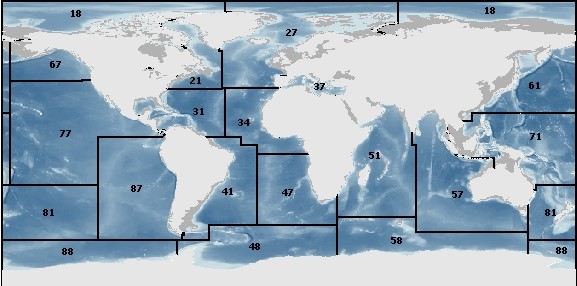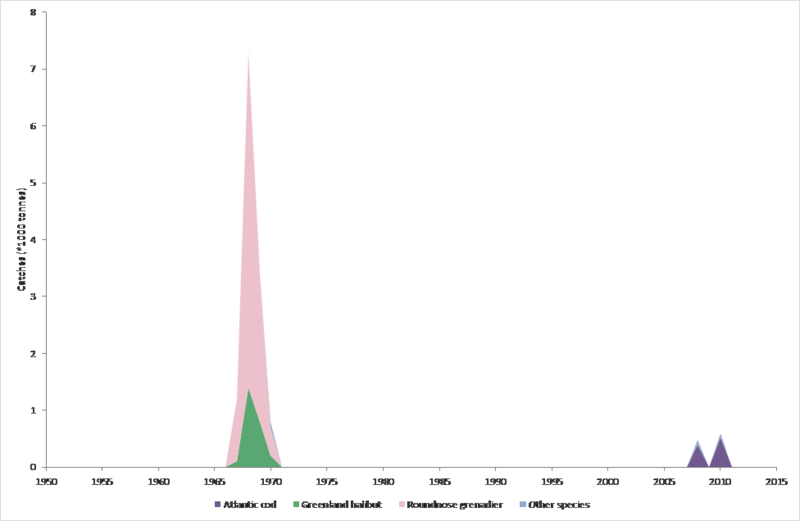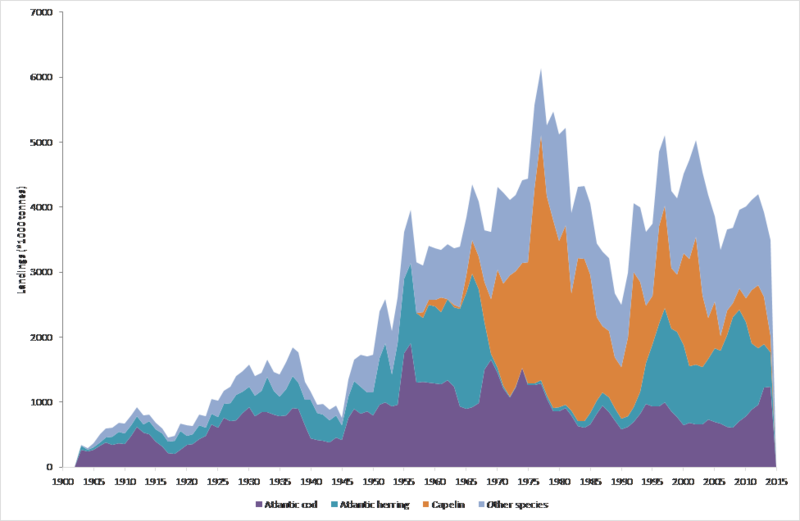
Changes in the Arctic fisheries places increasing importance on fisheries governance and management in the region. However, a significant portion of international waters in the Arctic Ocean is currently not covered by any specific fisheries regulatory framework. The compilation of catch data and identifying knowledge gaps are vital requirements to support management of the region, and could assist by giving:
- Indications of declining historic fisheries
- Indications of new, growing fisheries
- Measures of track records of fishing by different countries across the region as a whole.
This challenge focused on compiling vital fisheries data, i.e. removals by the fisheries.
Objective of the challenge
The objective of this challenge was to produce information tables for the whole sea-basin including:
- mass and number of landings of fish by species and year;
- mass and number of discards and bycatch (of fish, mammals, reptiles and seabirds) by species and year.
These tables include data from before and after the Data Collection Regulation came into force. The time-series is as long as possible, but its length varies between species. The available data has been scrutinised to identify current knowledge gaps while also considering future use of the data.
Main results
Fisheries landings
The term ‘landings’ is used for the portion of catch that is brought to shore, while the term ‘catch’ refers to the total fish captures, whether brought on board the vessel and landed or not (i.e. discards). Because landings exclude these discards, the weight of landings is less than the weight of the catch. It was not always clear whether the data presented for this objective related to commercial fisheries catch or fisheries landings.
Data sets provided by the Food and Agriculture Organization (FAO), the Northwest Atlantic Fisheries Organization (NAFO), and the International Council for the Exploration of the Sea (ICES) were used to compile fisheries landings (or catch) data for the Arctic area.
Read more about Fisheries landings

Figure 1: Map of Major FAO Fishing Areas (source: FAO)
FAO area 18
As FAO area 18 solely covers the Arctic area (i.e. Arctic sea), catches can be selected from the FAO database for this major fishing area. However, it is believed that the current catches stored in the FAO database for this fishing area are too low to be reliable (Zeller et al., 2011). Zeller et al. (2011) presents a catch reconstruction of the area for the period 1950-2006. This work has been extended in time to 2010 in the Seas Around Us Project (http://www.seaaroundus.org/). However, these catch reconstructions are based on assumptions of which their credibility could be contested.
Catch data can be accessed using the software package FishStatJ which can be downloaded from the FAO website. In order to access the catch data set, the global workspace also needs to be downloaded from the FAO website. The global workspace consists of four data sets; (i) global capture production, (ii) global aquaculture production, (iii) global commodities production and trade, and (iv) global production by production source. Once the workspace is imported into FishStatJ the relevant catch data set, i.e. global capture production, can be selected. The catch data set runs from 1950 onwards. The filter option enables one to select relevant major fishing area(s).
Source: http://www.fao.org/fishery/statistics/software/fishstatj/en
FAO area 21
The Northwest Atlantic (i.e. FAO area 21) is covered by the NAFO convention area which has been divided into a number of NAFO divisions. NAFO divisions 0A, 1A and 1B cover the Arctic part of the Northwest Atlantic. Catch statistics by year, country, gear, tonnage, main species have been downloaded for these divisions from the NAFO website (21B database) by decade for the period 1960-2014. As the different variables (i.e. country, gear, tonnage, main species) are coded in the data sets, data processing is required in order to present the data. Note that the total catch of USA by species is not included in the data.
The Northwest Atlantic Fisheries Organization (NAFO) is an intergovernmental regional fisheries management organization (RFMO) founded in 1979. It’s overall objective is “to contribute through consultation and cooperation to the optimum utilization, rational management and conservation of the fishery resources of the NAFO Convention Area” (http://www.nafo.int). The NAFO members (currently twelve) send their annual compilation of information on national catches and landings to the NAFO Secretariat.
Source: https://www.nafo.int/fisheries/frames
FAO area 27
For management purposes, the Northeast Atlantic (i.e. FAO area 27) is divided into ICES fishing areas. ICES areas I, II, Va and XIV cover the Arctic part of the Northeast Atlantic. Catch statistics by species, area, country and year for these areas have been downloaded from ICES website for the periods 1903-1949, 1950-2010 and 2006-2014. For the first two periods it is clearly stated that this concerns landings data, rather than catch data. For the third period it is not that clear.
The International Council for the Exploration of the Sea (ICES) is an intergovernmental science organization that “provides scientific advice on the marine ecosystem to governments and international regulatory bodies that manage the North Atlantic Ocean and adjacent seas” (http://www.ices.dk). ICES has been gathering and publishing fisheries statistics since 1904. Annual nominal catches in the Northeast Atlantic region are officially submitted by 20 ICES member countries (http://www.ices.dk). The current data is collected and coordinated in collaboration with the Statistical Office of the European Communities (Eurostat).
Source: http://www.ices.dk/Pages/default.aspx
Figures 2-4 show these first results.

Figure 2: Total annual catch or landings for the Arctic Sea. Source Arctic Sea: FAO

Figure 3: Total annual catch or landings for the Arctic part of the NW Atlantic (NAFO divisions 0A, 1A-F). Source Arctic part of the NW Atlantic: https://www.nafo.int/fisheries/frame

Figure 4: Total annual catch or landings for the Arctic part of the NE Atlantic (ICES areas I, II, Va, XIV). Source: ICES ICES Historical Landings 1903-1949; ICES, Copenhagen, Historical Nominal Catches 1950-2010; ICES, Copenhagen, Official Nominal Catches 2006-2014. ICES, Copenhagen
Discards and bycatch
Within this study the term ‘discards’ refers to that portion of unwanted catch (i.e. fish) which is returned, dead or alive, to the sea. The term ‘bycatch’ in this study refers to incidental catches of mammals, reptiles and seabirds. The amount of discards and bycatch depends on the fishing technique used. Generally, targeted single species fisheries generate few discards but can cause incidental bycatch of megafauna, while mixed fisheries (i.e. fisheries that target several species) may generate higher amounts of discards. Monitoring programmes, such as Observer or self-sampling programmes, are used to estimate the magnitude of discards and/or bycatch in different types of fisheries. Such collected data is not always reported, but can be presented in scientific journals or even in grey literature. Estimates of discards and bycatch are therefore less readily available than landings or catch data.
The available information that was been found on discards and bycatch for the Arctic area is scarce; only fragmented discards and bycatch information was found.
Read more about Discards and bycatch
Bycatch
The circumpolar Seabird Working Group of the CAFF (Conservation of Arctic Flora and Fauna) has published a report on Incidental Take of Seabirds in Commercial Fisheries in the Arctic Countries in 1998 (CAFF, 1998). The report examines the available information on incidental take of seabirds in commercial fisheries in the Arctic countries, namely USA (Alaska), Canada, Finland, Greenland, Iceland, Norway and Russia. The information presented is characterised by much uncertainty and lack of data concerning the incidental take of seabirds.
FAO area 21
Discards
The Scientific, Technical and Economic Committee for Fisheries (STECF) is actively trying to collate fisheries dependent information. This also includes discards information. It only contained data from EU Member States. Discards data for the ICES areas that cover the Arctic part of the Northeast Atlantic (I, II, Va and XIV) was downloaded from the data dissemination webpage. However, for ICES areas I, II and XIV time-series only contain data that are linked to Deep Sea species.
The Scientific, Technical and Economic Committee for Fisheries (STECF) provides input to help the European Commission implement the EU’s Common Fisheries Policy (CFP). The Commission consults the committee on all matters relating to conservation and management of living aquatic resources. Members of the STECF are nominated by the Commission. STECF may form internal working groups, whose meetings can also be attended by invited experts (https://stecf.jrc.ec.europa.eu/). The STECF Expert Working Group on Fisheries Dependent Information (FDI) is consulted by the Commission to assess fishing effort deployed and catches by fisheries and métiers (i.e. a fishing activity which is characterised by one catching gear group and a group of target species, operating in a given area during a given season). For this, STECF gathers FDI for all EU member states. Time series are provided as far back as possible for a number of defined fishing areas. Discards statistics are available by species, regulated gear, vessel length and country.
Source: https://datacollection.jrc.ec.europa.eu/
Bycatch
The ICES Working Group on Bycatch of Protected Species (WGBYC) has collated, stored and summarized annual bycatch data reported by European member states affected by the EC Council Regulation 812/2004 (ICES, 2015). This Regulation (EC, 2014) obliges member states to monitor bycatches of cetaceans in certain fisheries, certain periods of the year and certain European waters and to report the results of the monitoring to the EC. This has resulted in the WGBYC database which stores collected data on bycatch monitoring and assessment for protected species, including mammals, birds, turtles, and rare fish. The database runs from 2006 onwards.
Using data collected during 2006-2008 in the coastal monkfish and cod gillnet fisheries active in the Norwegian coast, Bjørge et al. (2013) have statistically modelled the bycatch rate of harbour porpoise (Phocoena phocoena). It is concluded that about 6900 harbour porpoises are taken annually in these fisheries.
Fangel et al. (2015) assessed the incidental bycatch of seabirds in Norwegian coastal commercial fisheries in 2009. The purpose was, amongst others, to quantify the magnitude of seabird bycatch rates and estimate total bycatch from the entire fleet by different estimators. Overall, the total bycatch of the screened fisheries was estimated at around 11000 birds in 2009.
Within this challenge it was therefore not possible to create a comprehensive overview of discards and bycatch for the Arctic area.
Problems and gaps
- The catches in the FAO database for area 18 were thought to be too low to be reliable. Alternative catch reconstructions existed, but these are based on assumptions which made their reliability questionable.
- For the catch data presented here it is not always clear whether it relates to commercial fisheries catch or fisheries landings.
- Collected data on discards and/or bycatch is less readily available than landings or catch data.
Recommendations
- Fisheries on crab, shrimp and shellfish are important benthic fisheries in the Arctic that are not covered in this challenge. Including benthic fisheries is recommended to provide a more thorough indication of fisheries in the Arctic for management purposes.
- It is recommended to allow public access to data on fisheries in the entire Arctic area for scientific and management use. This involves improved access to existing data, and updating international databases with information from national databases. At present, international databases are often lagging several years behind, and they present data in a format that does not provide access to more details via metadata.
Lessons learned
- As the Arctic area only covers parts of the FAO major fishing areas the FAO catch database is not sufficient for use in generating an overview of all landings/catches for the Arctic area. Data also needed to be extracted from the ICES and NAFO databases.
- It is not possible to generate an overall comprehensive overview of discards and bycatch in the Arctic area; only fragmented data has been found.
References
- Bjørge, A. M. Skern-Maurizen & M.C. Rossman, 2013. Estimated bycatch of harbour porpoise (Phocoena phocoena) in two coastal gillnet fisheries in Norway, 2006-2008. Mitigation and implications for conservation. Biological Conservation 161: 164-173.
- CAFF, 1998. Incidental Take of Seabirds in Commercial Fisheries in the Arctic Countries. Technical Report no. 1 from the Circumpolar Seabirds Working Group (CSWG). Editors: V. Bakken & K. Falk. 60 pp.
- EC, 2014. Council Regulation (EC) No 812/2004 of 26.4.2004 laying down measures concerning incidental catches of cetaceans in fisheries amending Regulation (EC) No 88/98.
- Fangel, K., Ø. Aas, J.H. Vølstad, K.M. Bærum, S. Cristensen-Dalsgaard, K. Nedreaas, M. Overvik, L.C. Wold & T. Anker-Nilssen, 2015. Assessing incidental bycatch of seabirds in Norwegian coastal commercial fisheries: Empirical and methodological lessons. Global Ecology and Conservation 4: 127-136.
- ICES, 2015. Report of the Working Group on Bycatch of Protected Species (WGBYC), 2-6 February 2015, ICES Headquarters, Copenhagen, Denmark. ICES CM 2015\ACOM: 26. 82 pp.
- Zeller, D., S. Booth, E. Pakmahov, W. Swartz & D. Pauly (2011). Arctic fisheries catches in Russia, USA and Canada: Baselines for neglected ecosystems. Polar Biology 34(7): 955-973.
